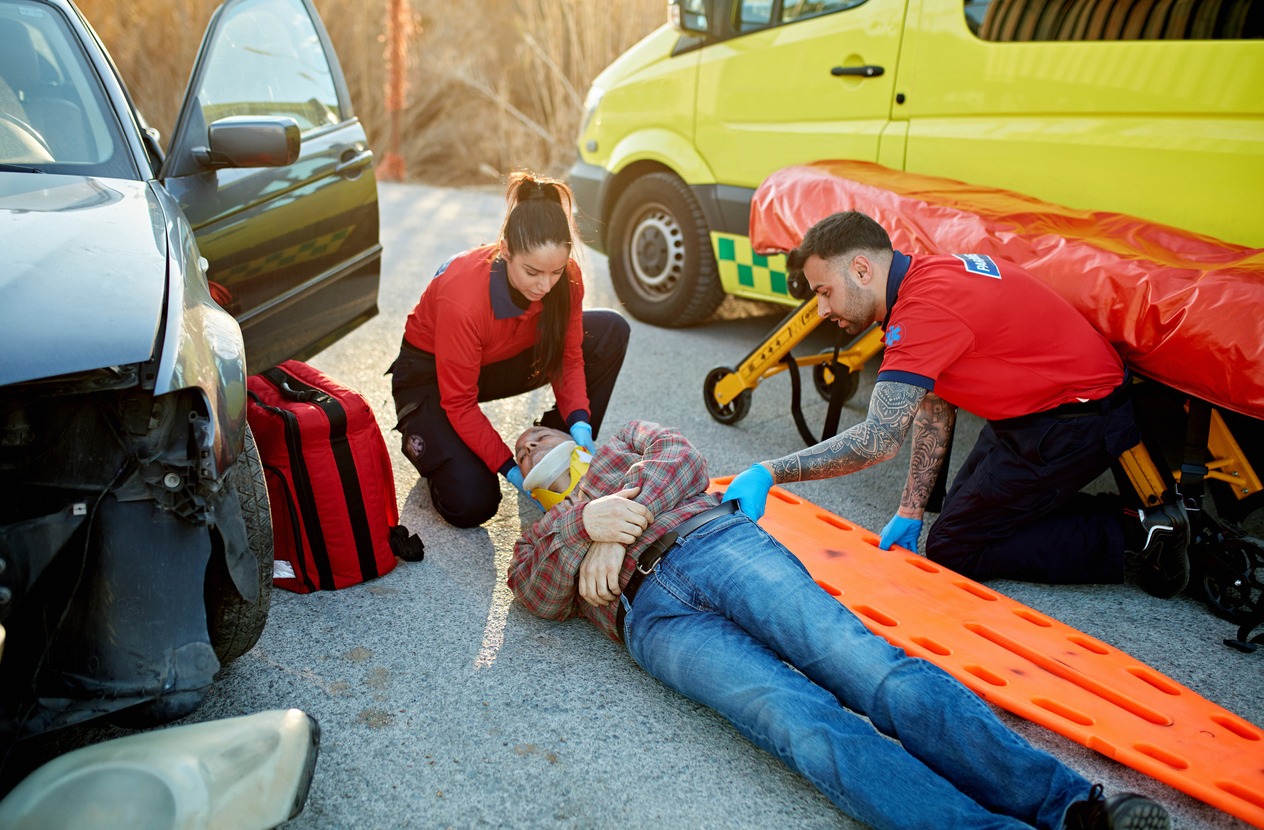
Rear-end collisions were the most common type of collision in Los Angeles from 2012 through 2021, according to California Highway Patrol data. The city saw 76,149 rear-end accidents during that time period, accounting for 29.66 percent of all car accidents. This resulted in 254 deaths and 117,306 injuries.
Rear-end accidents can happen for many reasons, from negligence by the lead driver or tailing driver, to a vehicle’s brake lights not working. There are many common injuries one might experience in a rear-end car accident, including serious injuries such as spinal cord injuries or traumatic brain injury.
This article will help you understand rear-end collision injuries and what to watch out for.
1. Whiplash

Whiplash is a neck injury commonly experienced after being rear-ended. This injury can be experienced even in a minor car accident. It is caused by the neck moving back and forth, rapidly and forcefully, like a whip cracking.
Symptoms of whiplash may not appear right away, but it can present muscular, spinal, and nervous system damage.
Symptoms and signs of whiplash include:
- Neck stiffness and pain
- Dizziness
- Fatigue
- Numbness or tingling in the arms
- Pain or tenderness in the arms, upper back or shoulder
- Headaches, typically starting at the skull’s base
- Loss of the neck’s range of motion
- Worsening pain when the neck moves
Some people with whiplash also experience:
- Depression
- Memory issues
- Problems concentrating
- Irritability
- Disturbances in sleep
- Tinnitus (ringing ears)
- Blurred vision
According to Accident Analysis and Prevention, there are over 1.2 million cases of whiplash each year.
2. Herniated Disc Injuries
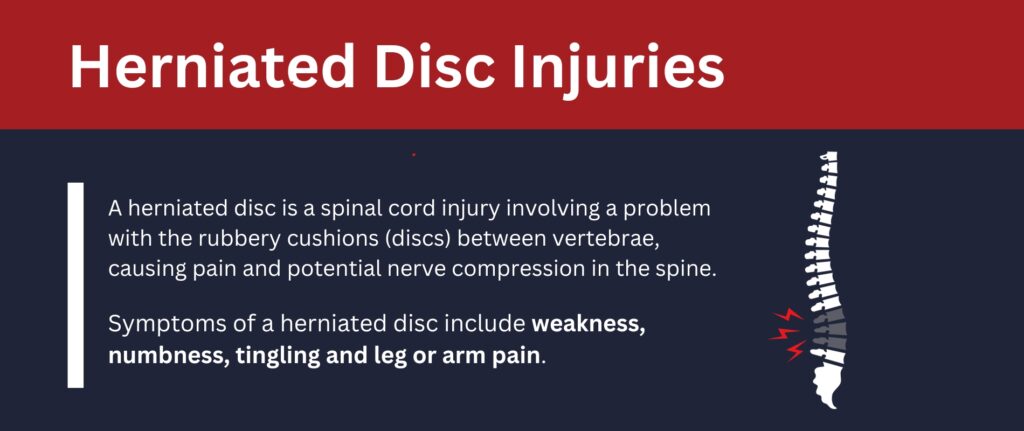
A herniated disc is a type of spinal cord injury. This injury refers to an issue with one of the discs, which are rubbery cushions, that sit in between bones that stack to make up the spine. These stacking bones are known as vertebrae.
Spinal discs have soft, jellylike centers known as nuclei. A nucleus is located inside a rubbery, tougher exterior which is called an annulus. Herniated discs occur when a part of the nucleus sticks out through a torn annulus. Herniated discs are sometimes referred to as ruptured discs or slipped discs.
There are over 33,000 cases of spinal disc injuries every year.
The symptoms of a herniated disc include:
Weakness
Muscles which are served by affected nerves often weaken. This may affect the ability you have to hold or lift items and may cause stumbling.
Tingling Or Numbness
Those with herniated discs quite often experience radiating tingling or numbness in body parts served by affected nerves.
Leg Or Arm Pain
For herniated discs in the neck, most will usually feel the majority of pain in their arm or shoulder. This pain can shoot into the leg or arm when you move into a certain position, sneeze or cough. This pain is often described as burning or sharp.
For herniated discs in the lower back, pain will usually be felt in the calf, thigh, buttocks and lower back. Foot pain is possible as well.
3. Spinal Stenosis

Spinal stenosis occurs when there is too little space inside a backbone. This leads to pressure on the spinal cord and spinal nerves. Stenosis of the spine occurs most commonly in the neck and the lower back.
Spinal stenosis is often caused by wear and tear related to arthritis. However, it’s also caused by car accidents.
About 11 percent of senior adults in the United States are impacted by spinal stenosis.
The symptoms of spinal stenosis in the neck include:
- Bladder or bowel problems
- Neck pain
- Problems with balance and walking
- Weakness or tingling in an arm, foot, leg or hand
- Numbness
Lower back spinal stenosis can lead to cramping or pain in one leg or both legs. Pain or cramping can occur after standing for extended periods of time or when walking. Symptoms improve when sitting or bending forward. Back pain can also be experienced.
4. Spinal Fracture
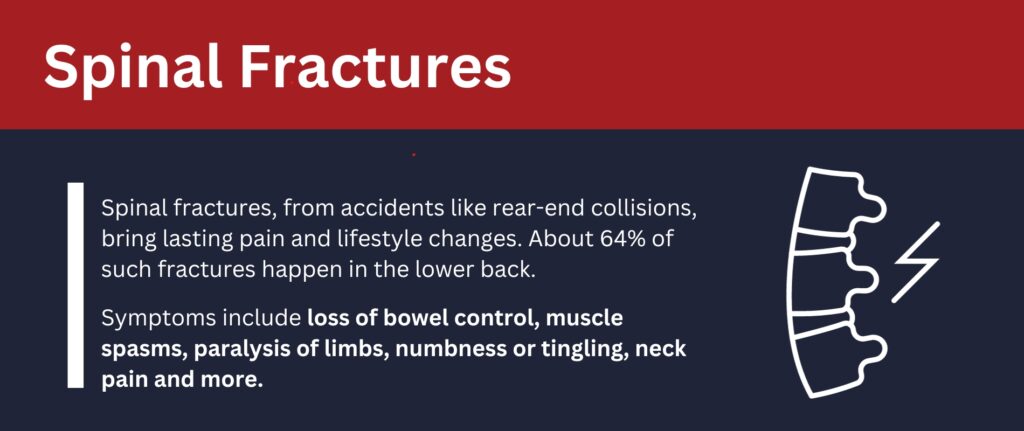
A sudden traumatic impact can cause one or more of your spinal vertebrae to fracture. There are two types of spinal fracture injuries: burst fractures and fracture dislocations. Both types can cause lifetime pain and lifestyle changes, even when medically treated immediately after the rear-end accident. Overall, 64% of spinal fractures occur in the lower back.
Minor spinal fractures may be healed by medication and rest. Fractures which are more severe may need surgery for bone realignment. Spinal fractures which are left untreated may lead to paralysis, nerve damage and permanent injury to the spinal cord.
Spinal fracture types include:
Chance fracture: This is a fracture which is caused when vertebrae are pulled apart by a forward flexed injury which is violent. These typically occur in car accidents.
Axial burst fracture: This is a fracture caused when a vertical impact or fall causes a loss of height on the back and front of vertebra.
Compression fracture: This is a fracture typically caused by osteoporosis, tumors or spinal abnormalities. The front of the vertebra deteriorates and fractures while the vertebra’s back stays stable.
Spinal fracture symptoms include:
- Loss of bowel or urinary control
- Muscle spasms
- Paralysis or weakness of limbs
- Numbness or tingling
- Pain in the neck or back
5. Traumatic Brain Injury
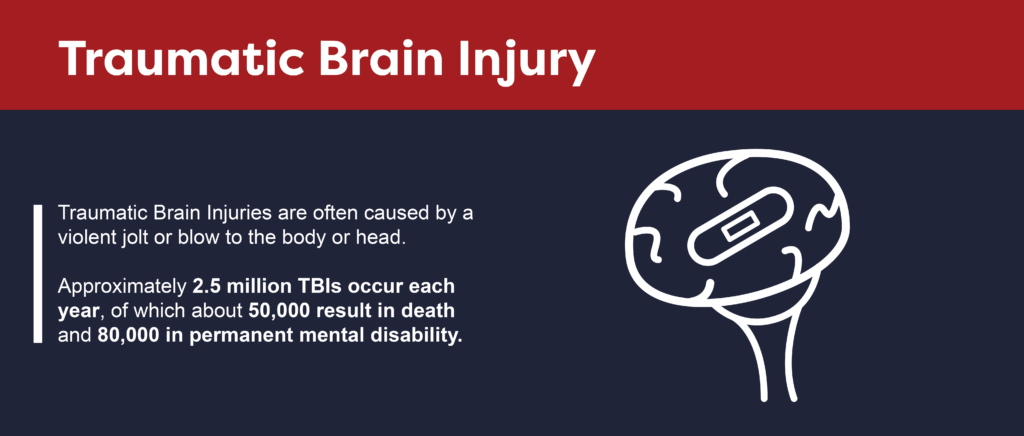
Traumatic brain injuries (TBIs) are often the result of a violent jolt or blow to the body or head. These injuries can also be caused by objects that pass through brain tissue, like bullets or shattered pieces of skull. A concussion is a type of traumatic brain injury that is commonly seen in rear-end accidents.
Approximately 2.5 million TBIs occur each year, of which about 50,000 result in death and over 80,000 result in permanent mental disability.
Traumatic brain injuries can sometimes lead to physical damage to the brain like bleeding, torn tissues and bruising. Injuries like these can cause death or long-term complications.
Symptoms and signs of mild traumatic brain injuries include:
- Loss of balance
- Dizziness
- Speech problems
- Drowsiness
- Fatigue
- Vomiting
- Nausea
- Headache
- Sensitivity to sound or light
- Blurred vision
- A change in sense of smell
- Bad tastes in the mouth
- Tinnitius (ringing ears)
- Sleeping too much
- Problems sleeping
- Anxiety
- Depression
- Mood swings or changes
- Concentration or memory issues
- Being disoriented, confused or dazed
- Loss of consciousness
Symptoms and signs of moderate traumatic brain injuries and severe traumatic brain injuries include:
- Loss of consciousness lasting for minutes to hours
- Coordination loss
- Numbness or weakness in toes and fingers
- Inability to wake up
- Clear fluid draining from the ears or nose
- Pupil dialation
- Seizures or convulsions
- Nausea or repeated vomiting
- Headache which worsens
- Persistent headache
- Coma or other consciousness disorders
- Speech slurring
- Unusual behavior such as combativeness or agitation
- Profound confusion
6. Arm And Leg Injuries
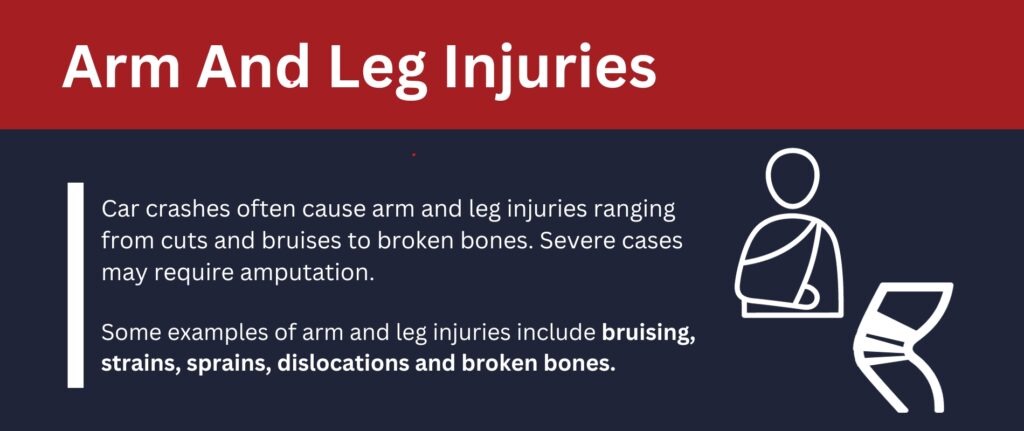
Arm and leg injuries are common in a crash because humans naturally bring up their limbs to protect the head, neck, and body when there is danger. You may have a broken long bone, dislocated knee or elbow, or cuts and bruises from debris inside the car or being thrown around. If severe enough, amputation may even be necessary
Injuries to the arms and legs can include:
Bruising: Colored marks which are caused when bleeding occurs in the skin or under it.
Strain: This is a muscle injury – its symptoms include sudden, sharp pain and loss of power in an affected area.
Sprain: This is a ligament injury – its symptoms include loss of mobility, bruising, pain and swelling.
Dislocation: This is when a bone gets dislodged or moved – dislocated joints look out of place and inability to move, pain, weakness, numbness, discoloration, bruising and swelling may be present.
Broken bones: The symptoms of broken bones include severe pain, swelling, tenderness, discoloration, a change in a limb’s shape, and restricted movement or lack of movement in the limb which is affected.
Rotator cuff injuries and nerve damage are also arm and leg injuries which are commonly seen in rear-end accidents.
When arm and leg injuries are severe enough, sometimes amputation is necessary.
7. Facial Trauma

Facial trauma is trauma to the soft tissue or bone of the face.
These are common rear-end collision injuries and can lead to permanent disfiguring damage or damage to your sensory organs, such as your eyes or nose. It can occur if your head hits the car structure during the crash or fragments of glass or dashboard get into your eyes. Facial injuries may require extensive reconstructive surgery with additional pain and suffering.
Facial trauma may involve deformity, burns, cuts, lacerations, bruising, swelling or facial bleeding.
Large, complex facial injuries might necessitate facial reconstruction surgery.
It is important for facial trauma to be treated since human faces are intricate, containing many sensory organs, muscles, nerves, blood vessels and bones. Untreated facial trauma can lead to disfigurement as well as the permanent loss of functions such as swallowing, speaking, chewing or seeing.
8. Internal Injuries
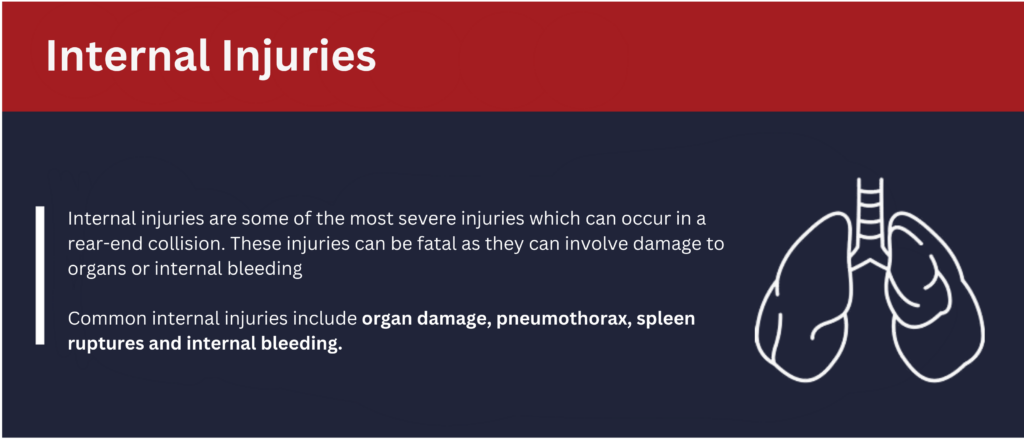
Internal injuries are some of the more severe injuries which can occur in a rear-end collision. These injuries can be fatal as they can involve damage to organs or internal bleeding.
Common internal injuries include:
- Organ damage
- Pneumothorax
- Spleen rupture
- Internal bleeding
Pneumothorax is common internal rear-end collision injury. This is a collapsed lung. It occurs when air ends up in the space between the chest wall and lung – the air pushes on the lung, collapsing it. Symptoms include shortness of breath and chest pain, and collapsed lungs can be life-threatening.
Another common internal injury seen in rear-end collisions is a ruptured spleen. This is a medical emergency. The spleen helps the body fight infections, and it filters old blood cells from the bloodstream. Ruptured spleens can cause life-threatening internal bleeding.
Common internal injuries include:
9. Sprains And Strains
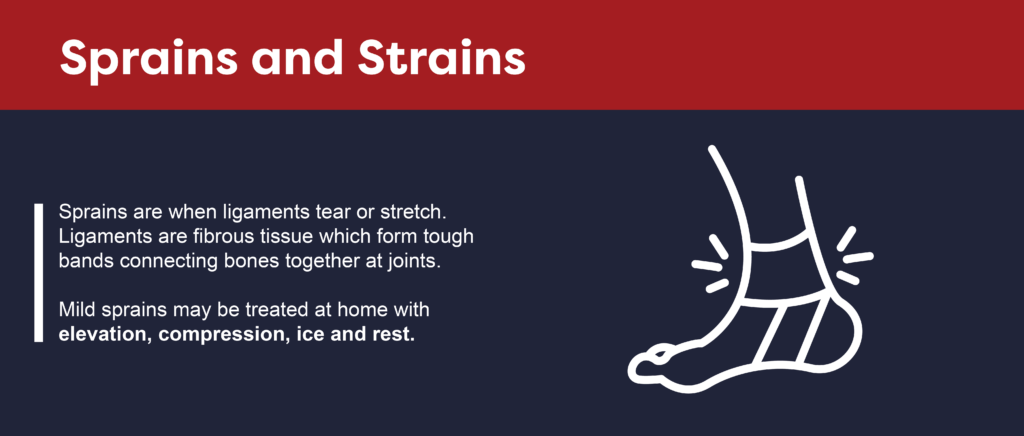
Sprains are when ligaments tear or stretch. Ligaments are fibrous tissue which form tough bands connecting bones together at joints.
Mild sprains may be treated at home with elevation, compression, ice and rest. Severe sprains may necessitate surgery in order to repair a torn ligament.
Symptoms of sprains include:
- Feeling or hearing a “pop” when the injury occurs
- Limited movement of an affected joint
- Bruising
- Swelling
- Pain
Muscle strains are injuries to muscles or tendons – fibrous tissue that connects bones to muscles. Minor strains might only lead to a muscle or tendon being overstretched, while more severe strains can involve tears of these tissues.
Minor strains can be treated at home with elevation, compression, ice and rest, whereas severe strains may need surgical repair.
The symptoms and signs of strains include:
- Muscle weakness
- Swelling
- Muscle spasms
- Limited motion
- Bruising or redness
- Tenderness or pain
10. Bone Fractures
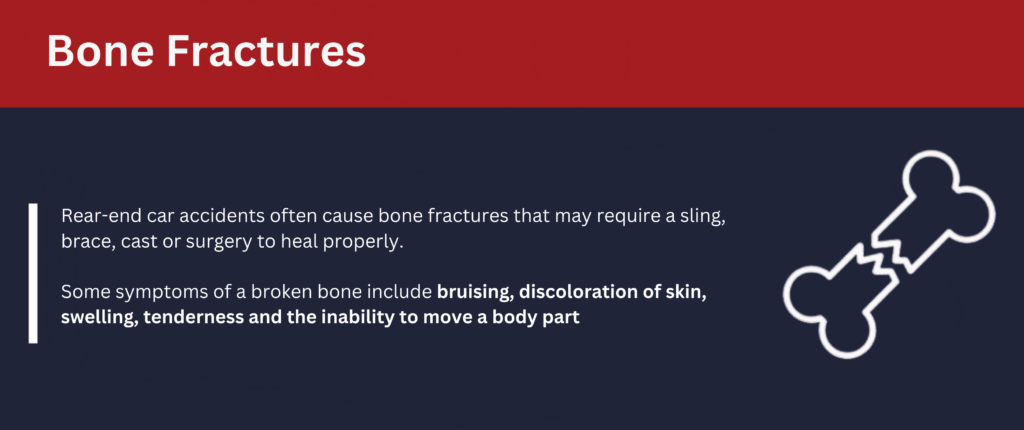
Bone fractures are broken bones. They are frequently caused by trauma like a rear-end car accident, a fall or a sports injury.
Broken bones sometimes necessitate surgery. Some people with broken bones only require a sling, brace, cast or splint for a broken bone to heal. The time it takes for full recovery depends on what bone is broken, where the bone is broken and the cause of the break.
The symptoms of a broken bone include:
- A bump or deformity that typically isn’t present on your body
- Discoloration or bruising
- An inability to move a body part like you typically can
- Tenderness
- Swelling
- Pain
11. Mental Injuries
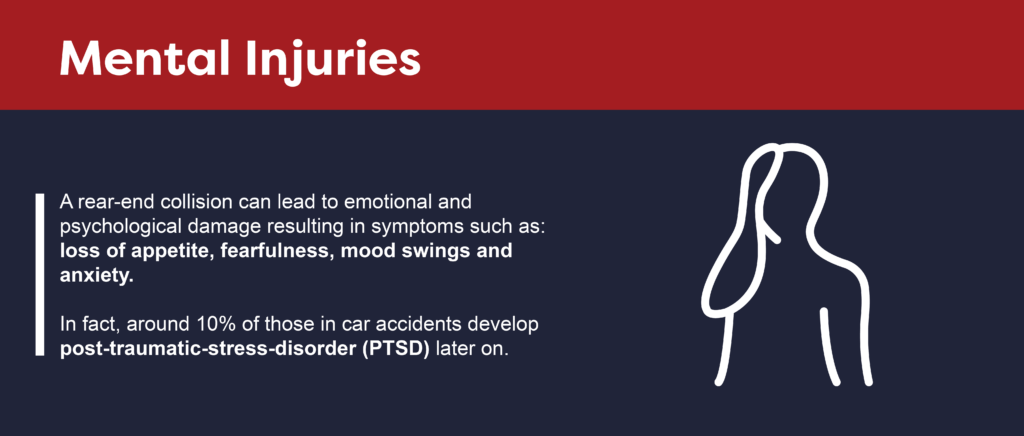
A rear-end collision can lead to emotional and psychological damage. Car accidents can cause emotional distress which can cause numerous symptoms such as:
- Loss of interest in activities you’re typically interested in
- Loss of appetite
- Nightmares and sleep problems
- Crying
- Feeling humiliated
- Fearfulness
- Anger bouts
- Mood swings
- Anxiety
- Mental anguish
One particularly common and debilitating mental injury seen after rear-end collisions is post-traumatic stress disorder. Around ten percent of those in car accidents develop PTSD later on.
Some symptoms of PTSD are:
- Recurring, involuntary and intense memories regarding the accident
- Self-harm
- Withdrawal from society
- Depression
- Intense physical or emotional distress upon encountering a reminder
- Avoiding things that remind you about an accident, like being around cars, riding in cars, and driving
- Nightmares
- Flashbacks that cause a period of “blackout”
12. Fatalities
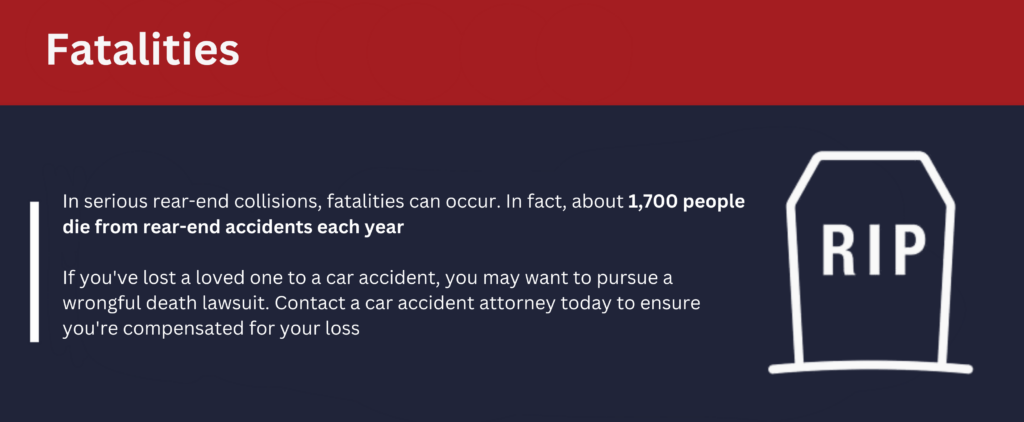
In the worst-case scenario, people can die in rear-end collisions.
If you or a loved one has been injured or killed in a rear-end collision that wasn’t your fault, contact our legal team today for a free consultation with a car accident lawyer. We can help you recover compensation for medical bills, lost wages, property damage, pain, suffering, wrongful death and more.
If you can’t afford medical treatment we can get you to doctors who won’t charge for treatment until your case is over.
Best of all, we won’t charge you a fee until and unless we recover compensation for you – our only fee is a percentage of whatever compensation we recover for you.
Call us today so we can put our experience to work for you and recover the compensation for your rear-end collision injuries that you deserve.

